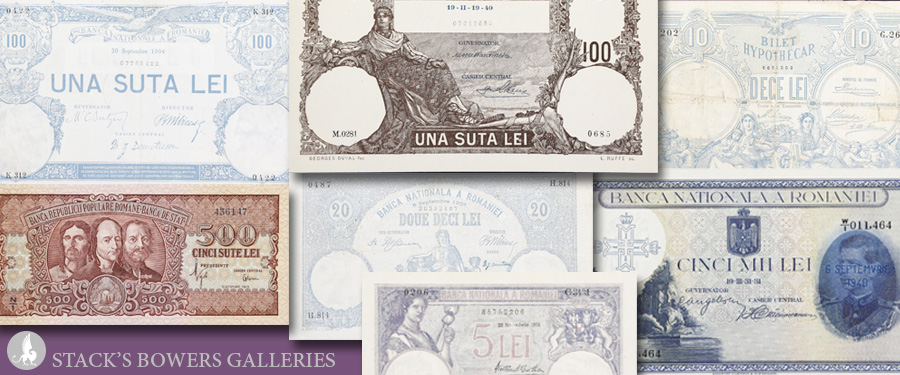
We are putting the final touches on our upcoming catalog for the Maastricht Showcase Auction, to be held in early May. As part of that sale, and also in our May Collectors Choice Online Auction held in the middle of May, we will be offering the Damian Collection of Romanian Paper Money. Spanning from the country’s first series to modern notes, the collection is a comprehensive overview and will be of particular interest to specialized collections of this southeastern European country. As I was cataloging the collection, I was surprised and impressed that some notes, which at first glance appeared to be fairly common, turned out to be rare dates or watermark varieties. If you are interested in Romanian paper money, this is certainly a collection to pay attention to.
The first paper money for Romania was issued in 1877 following the Russo-Turkish War, in which Romania sided with the Russians and was subsequently recognized as an independent nation. These early notes were called bilet hypothecar, or mortgage notes, that were backed by property owned by the state. This issue consisted of denominations ranging from 5 Lei to 500 Lei and were withdrawn within a few years. This series was followed by paper money issued by the National Bank of Romania, which first entered circulation in 1880 and replaced the previous bilet hypothecar, which while technically not paper money, circulated as such.
Nineteenth century Romanian notes, as well as many issued in the first decades of the twentieth century were designed by French artists; while they carry a distinct Romanian flair they are closely related to contemporary French notes. These were followed by notes printed by the National Bank of Belgium and the National Bank of Romania using similar French-inspired designs. One unusual aspect of many of this type is the date, which appears in a somewhat odd format. For example, 22 April 1920 appears on the notes as 19 IV – 22 20, where the Roman numeral is the month, followed by the day, and the first and last set of numbers making up the year.
In the first few decades after World War II, Romania fell under Soviet influence, becoming a communist state in 1947 under the leadership of Gheorghe Gheorghiu-Dej, who pursued industrialization, collectivization of agriculture, and political repression. After Nicolae Ceaușescu took power in 1965, Romania maintained a more independent foreign policy from Moscow while intensifying internal control through an oppressive surveillance state and economic austerity. While notes from this era are more available, there are scarce watermark and serial number varieties.
The Damian Collection of Romania provides an excellent overview of the paper money from Romania. Two notes from the 1877 series are offered, followed by a wide selection of notes from the early twentieth century. Many notes are offered in very collectible condition, including many that have been awarded the ‘EPQ’ designation by PMG. The collection is complemented by other rare notes from Romania and elsewhere in the region. We recommend that you keep an eye on the upcoming Maastricht sale as well as the May CCO sale. While consignments for the Maastricht sale have now closed, we are always accepting quality consignments for future sales. To get the consignment process started, please contact Dennis Hengeveld at [email protected] or call 800-458-4646.





